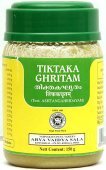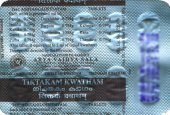Trayamana, Trāyamāṇā, Trāyamāṇa: 11 definitions
Introduction:
Trayamana means something in Hinduism, Sanskrit, biology. If you want to know the exact meaning, history, etymology or English translation of this term then check out the descriptions on this page. Add your comment or reference to a book if you want to contribute to this summary article.
In Hinduism
Ayurveda (science of life)
Rasashastra (Alchemy and Herbo-Mineral preparations)
Source: Wisdom Library: Rasa-śāstraTrāyamāṇā (त्रायमाणा):—One of the sixty-seven Mahauṣadhi, as per Rasaśāstra texts (rasa literature). These drugs are useful for processing mercury (rasa), such as the alchemical processes known as sūta-bandhana and māraṇa.
Cikitsa (natural therapy and treatment for medical conditions)
Source: Wisdom Library: Ayurveda: CikitsaTrāyamāṇa (त्रायमाण) is a Sanskrit word referring to the “India gentian” plant, a species of plant from the Gentianaceae (gentian) family of flowering plants. It is used throughout Ayurvedic literature such as the Caraka-saṃhitā. It is also known as Trāyantī. Its official botanical name is Gentiana kurroo and is commonly referred to in English as “Himalayan gentian” and “Indian gentian”. It is a critically endangered plant found throughout the Himalayan mountain range. The literal translation of Trāyamāṇa, is “preserving” or “protecting”. The name Trāyamāṇā could also refer to Delphinium zalil, a perennial plant from the Ranunculaceae (buttercup) family of flowering plants.
This plant (Trāyamāṇa) is also mentioned as a medicine used for the treatment of all major fevers, as described in the Jvaracikitsā (or “the treatment of fever”) which forms the first chapter of the Sanskrit work called Mādhavacikitsā.
Kalpa (Formulas, Drug prescriptions and other Medicinal preparations)
Source: Shodhganga: Edition translation and critical study of yogasarasamgrahaTrāyamāṇā (त्रायमाणा) refers to the medicinal plant known as “Gentiana kurroo Royle” and is dealt with in the 15th-century Yogasārasaṅgraha (Yogasara-saṅgraha) by Vāsudeva: an unpublished Keralite work representing an Ayurvedic compendium of medicinal recipes. The Yogasārasaṃgraha [mentioning trāyamāṇā] deals with entire recipes in the route of administration, and thus deals with the knowledge of pharmacy (bhaiṣajya-kalpanā) which is a branch of pharmacology (dravyaguṇa).
Nighantu (Synonyms and Characteristics of Drugs and technical terms)
Source: WorldCat: Rāj nighaṇṭuTrāyamāṇā (त्रायमाणा) is the Sanskrit name for a medicinal plant identified with Gentiana kurroo Royle. from the Gentianaceae family of flowering plants, according to verse 5.57-59 of the 13th-century Raj Nighantu or Rājanighaṇṭu. Trāyamāṇā is commonly known in Hindi as Karu, Kaḍu, Kuṭakī or Nīlkaṇṭha; in Bengali as Karu or Kuchi; and in [J.K.?] as Nīlkaṇṭha, Teeta or Trāmāṇ (Trāmāṇa).
Trāyamāṇā is mentioned as having fifteen synonyms: Kṛtatrāṇa, Trāyantī, Trāyamāṇikā, Balabhadrā, Sukāmā, Vārṣikī, Girijā, Anujā, Maṅgalyāhvā, Devabalā, Pālanī, Bhayanāśinī, Avanī, Rakṣaṇī and Trāṇā.
Properties and characteristics: “Trāyamāṇā is cooling (śīta) and sweet (madhura). It quells gulma (false abdominal lumps due to wind) fevers, vitiated kapha and blood disorders. It controls vertigo, thirst, tuberculosis, exhaustion, poisonous affections and vomitting”.

Āyurveda (आयुर्वेद, ayurveda) is a branch of Indian science dealing with medicine, herbalism, taxology, anatomy, surgery, alchemy and related topics. Traditional practice of Āyurveda in ancient India dates back to at least the first millenium BC. Literature is commonly written in Sanskrit using various poetic metres.
Biology (plants and animals)
Source: Wisdom Library: Local Names of Plants and DrugsTrayamana in the Malayalam language is the name of a plant identified with Gentiana kurroo Royle from the Gentianaceae (Gentian) family. For the possible medicinal usage of trayamana, you can check this page for potential sources and references, although be aware that any some or none of the side-effects may not be mentioned here, wether they be harmful or beneficial to health.
Trayamana in the Sanskrit language, ibid. previous identification.
Source: Google Books: CRC World Dictionary (Regional names)1) Trayamana in India is the name of a plant defined with Delphinium saniculifolium in various botanical sources. This page contains potential references in Ayurveda, modern medicine, and other folk traditions or local practices.
2) Trayamana is also identified with Delphinium zalil.
3) Trayamana is also identified with Ficus heterophylla It has the synonym Ficus scabrella Roxb. (etc.).
4) Trayamana is also identified with Gentiana kurroo It has the synonym Pneumonanthe kurroo D. Don.
Example references for further research on medicinal uses or toxicity (see latin names for full list):
· Diagnoses plantarum orientalium novarum (1846)
· Supplementum Plantarum (1782)
· Annals of the Royal Botanic Garden. Calcutta. (1888)
· Flora de Filipinas (1837)
· Flora Indica (1832)
· Species Plantarum (1753)
If you are looking for specific details regarding Trayamana, for example side effects, health benefits, diet and recipes, pregnancy safety, extract dosage, chemical composition, have a look at these references.

This sections includes definitions from the five kingdoms of living things: Animals, Plants, Fungi, Protists and Monera. It will include both the official binomial nomenclature (scientific names usually in Latin) as well as regional spellings and variants.
Languages of India and abroad
Sanskrit dictionary
Source: Cologne Digital Sanskrit Dictionaries: Shabda-Sagara Sanskrit-English DictionaryTrāyamāṇa (त्रायमाण).—mfn.
(-ṇaḥ-ṇā-ṇaṃ) A preserve, preserving. f.
(-ṇā) A medicinal plant. E. trai to preserve, affix śānac .
Source: Cologne Digital Sanskrit Dictionaries: Monier-Williams Sanskrit-English Dictionary1) Trāyamāṇa (त्रायमाण):—[from trāyantikā > trā] mfn. preserving, protecting, [Ṛg-veda; Atharva-veda] etc.
2) Trāyamāṇā (त्रायमाणा):—[from trāyamāṇa > trāyantikā > trā] f. Ficus heterophylla, [vi, 107, 1 f.; viii, 2, 6; Suśruta i, 38 and 42; iv, vi; Varāha-mihira’s Bṛhat-saṃhitā xliv, 10] (ṇa mn.) and, [iil, 39.]
Source: Cologne Digital Sanskrit Dictionaries: Yates Sanskrit-English DictionaryTrāyamāṇa (त्रायमाण):—[(ṇaḥ-ṇā-ṇaṃ) a.] Preserving. f. A medical plant.
[Sanskrit to German]
Sanskrit, also spelled संस्कृतम् (saṃskṛtam), is an ancient language of India commonly seen as the grandmother of the Indo-European language family (even English!). Closely allied with Prakrit and Pali, Sanskrit is more exhaustive in both grammar and terms and has the most extensive collection of literature in the world, greatly surpassing its sister-languages Greek and Latin.
See also (Relevant definitions)
Full-text (+17): Trana, Subhadrani, Anuja, Balabhadrika, Trayamanika, Rakshani, Sukama, Balabhadra, Girija, Trayantika, Trayanti, Avani, Baladeva, Bhadranamika, Brahmabhadra, Mangalyarha, Kritatra, Palani, Bhayanashini, Mangalyahva.
Relevant text
Search found 10 books and stories containing Trayamana, Trāyamāṇā, Trāyamāṇa; (plurals include: Trayamanas, Trāyamāṇās, Trāyamāṇas). You can also click to the full overview containing English textual excerpts. Below are direct links for the most relevant articles:
Rig Veda (translation and commentary) (by H. H. Wilson)
Atharvaveda and Charaka Samhita (by Laxmi Maji)
Medicinal herbs and plants in the Atharva-veda < [Chapter 3 - Diseases and Remedial measures (described in Atharvaveda)]
Classification of Drugs in the Caraka-Saṃhitā < [Chapter 4 - Diseases and Remedial measures (described in Caraka-saṃhitā)]
1b. Study of Fever (Jvara) in the Caraka-Saṃhita < [Chapter 5 - Diseases and Remedies in Atharvaveda and Caraka-Saṃhitā]
Hiranyakesi-grihya-sutra (by Hermann Oldenberg)
Brihat Samhita (by N. Chidambaram Iyer)
Sushruta Samhita, volume 4: Cikitsasthana (by Kaviraj Kunja Lal Bhishagratna)
Chapter IX - The medical treatment of cutaneous affections
Rasa Jala Nidhi, vol 3: Metals, Gems and other substances (by Bhudeb Mookerjee)
Part 24 - Usage of poisons < [Chapter XXX - Visha (poisons)]
Related products





